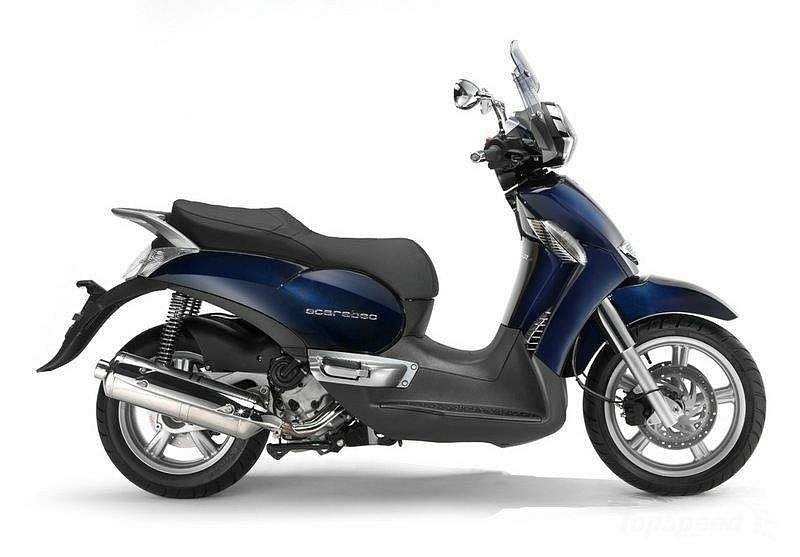Aprilia Scarabeo 500ie (2013)
The Aprilia Scarabeo 500ie is a motorcycle with a four-stroke, liquid-cooled single cylinder engine that has a capacity of 460cc. It has a compression ratio of 10.5:1, an electronic CDI ignition with automatic timing, and an automatic, centrifugal, dry clutch. The motorcycle has a maximum power of 29kW/39hp at 7500 rpm and a maximum torque of 43Nm/4.8kgf-m/31.2lb-ft at 5500 rpm. The transmission is automatic with a continuous variator and the final drive is a belt. The frame is made of high strength tubular steel with a closed double cradle and the front suspension is a hydraulic fork with sleeve of about 40mm while the rear suspension is the engine functioning as a swinging fork swingarm linked to the frame by dual connecting rods and two radial silent blocks. The rear suspension also boasts two double-action gas shock absorbers with preload adjustment. Overall, the Aprilia Scarabeo 500ie has a powerful engine, modern electronics, and a sturdy frame that ensures a smooth ride.
Technical specifications:
Make Model: Aprilia Scarabeo 500ie
Year: 2013
Engine: Four stroke, single cylinder, SOHC, 4 valves
Capacity: 460 cc / 28.1 cu in
Bore x Stroke: 92 x 69 mm
Compression Ratio: 10.5:1
Cooling System: Liquid cooled
Lubrication: Wet sump, forced circulation with mechanical pump
Engine Oil: Semi-synthetic, 5W/40
Induction: EFI
Spark Plug: NGK CR7EKB
Ignition: Electronic CDI ignition with automatic timing.
Starting: Electric
Generator: 12V – 380W
Max Power: 29 kW / 39 hp @ 7500 rpm
Max Torque: 43 Nm / 4.8 kgf-m / 31.2 lb-ft @ 5500 rpm
Clutch: Automatic, centrifugal, dry
Transmission: Automatic with continuous variator
Final Drive: Belt
Frame: High strength tubular steel frame with closed double cradle
Front Suspension: Hydraulic fork, sleeve ~A40 mm.
Front Wheel Travel: 103 mm / 4.0 in
Rear Suspension: Engine functions as swinging fork swingarm, linked to the frame by dual connecting rods and two radial silent blocks. Two double-action gas shock absorbers with preload adjustment.
Related models:
- Aprilia Tuareg 250 Rally (1984-85)

- Aprilia RS125 R (2009)



- Aprilia RSV 1000 Mille R Factory (2005)



- Aprilia SL 750 Shiver (2013)



- Aprilia SR 50 Factory (2015)



- Aprilia Tuareg 350 Wind (1987)



- Aprilia Tuono 125 (2003-05)



- Aprilia SR Max 300 (2010-11)



- Aprilia Tuarg 600 Wind (1990-91)



- Aprilia Tuono 1000R Factory (2009)



- Aprilia SMV 750 Dorsoduro (2014)



- Aprilia SMV 750 Dorsoduro (2011)



- Aprilia SMV 1200 Dorsoduro (2011)



- Aprilia SMV 1200 Dorsoduro (2012)



- Aprilia Tuareg 125 Rally (1984)



- Aprilia TX 311M (1985)



- Aprilia Tuono 1000R Limited Edition (2003)



- Aprilia SXV 550 (2010-11)































